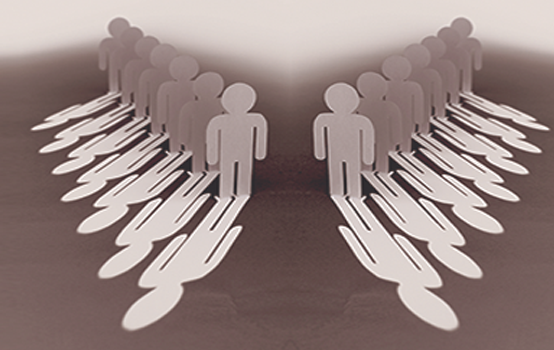
A program in which students learn in interdependent peer groups shows promise for preventing risky behaviors.
As children reach adolescence, peer groups gain a special power to influence their behavior, thanks in part to developmental changes that emphasize the vital importance of being accepted among friends and associates (Steinberg & Monahan, 2007). Groups of friends establish certain social norms, and behavior that adheres to these norms is rewarded with expressions of support and approval, whereas behavior that deviates from group norms may bring disapproval or rejection.
When group norms promote positive behavior, such as getting good grades, these peer influences can be beneficial. Unfortunately, some peer groups will take on antisocial behavioral norms that reinforce delinquent behavior. Thus, during the middle school years, teachers may notice groups of students using tobacco, alcohol, or other drugs or engaging in other risky behavior. Once these negative behavioral norms are established, they can be difficult to change. What’s more, they can attract other students who are predisposed to similar behaviors into the group, a process known as homophily. When homophily occurs among bullies, for example, bullying behavior is socially reinforced, causing it to continue and even grow among group members. Research on adolescent behavior reveals that associating with the wrong peer group can put students at risk for a variety of negative long-term outcomes, including school dropout, substance abuse, and violent behavior (Farmer et al., 2003; Van Ryzin & Dishion, 2013, 2014).
Many prevention and social-emotional learning (SEL) programs have attempted to counteract negative peer influence by targeting behaviors such as bullying and alcohol and drug use, yet these programs have several weaknesses. First, research on these programs often reports small effects or no effects at all (Greenberg et al., 2003; Tobler et al., 2000; Wilson, Gottfredson, & Najaka, 2001). Even if schools implement the programs exactly as specified, the benefits may be too small to justify the ongoing use of the program. Second, many of these programs are expensive and complex, requiring schools to sacrifice a great deal of instructional time. Third, sustaining these programs may be difficult, given the need to enroll new staff in official training programs and repurchase program materials or licenses year after year. Finally, many programs tend to follow a “cookbook” approach, in which teachers are required to follow a program manual word-for-word and step-by-step, which can be frustrating for teachers accustomed to a greater degree of control.
Collaborative peer learning
In our research, we evaluated an approach to prevention that attempts to harness the power of peer influence through collaborative, group-based peer-learning activities. These activities brought together students from different social groups, putting at-risk youth in contact with low-risk, prosocial youth who could provide more positive social influence. By interrupting the process of homophily among at-risk youth, we hoped to reduce social reinforcement for negative or antisocial behavior, which would result in lower rates of growth in delinquent and aggressive behavior over time.
For group-based peer-learning activities to promote social integration, teachers must establish a social context that promotes the breakdown of biases and prejudices among students who belong to different social groups (Pettigrew, 1998; Pettigrew & Tropp, 2008). A key ingredient of such a social context is “positive interdependence,” which occurs when individuals can attain their goals if (and only if) others in their group also reach their goals. For example, teachers may require a single finished product from a group (goal interdependence) or may offer a reward to the group if everyone achieves above a certain threshold (reward interdependence). Members of the group can be issued different materials that the group must share to complete the lesson (resource interdependence), or each member of the group could be assigned a different role to play (role interdependence). The group may have its own name (identity interdependence), or each group member may have to complete a different step in a task, like on an assembly line (task interdependence). These varied forms of positive interdependence can be layered upon one another in a single lesson, increasing the incentive for students to collaborate.
Associating with the wrong peer group can put students at risk for a variety of negative long-term outcomes.
When positive interdependence is established, students are more likely to promote one another’s success, instead of competing with or ignoring one another. These positive social interactions, in turn, encourage greater social acceptance and positive relationships among students and, in educational contexts, promote greater academic motivation and achievement (Johnson & Johnson, 1989, 2005). In fact, research on social interaction suggests that gains in social skills alone are insufficient to reduce social problems and encourage more positive peer relations. Only positive interdependence, and the subsequent positive social interactions, can motivate youth to reevaluate previous conclusions regarding others’ social desirability (Bierman, 2004).
In addition to promoting positive interdependence, however, peer-learning activities should also include individual accountability to ensure students have an incentive to contribute to the success of the group. For example, individual accountability could include an end-of-unit test to be taken individually (with the potential for group rewards) or an oral quiz in which the teacher randomly chooses an individual group member to summarize the group’s work. Finally, a high-quality collaborative lesson should include:
- Explicit coaching in collaborative skills, which includes (a) setting expectations for group behavior and (b) teacher monitoring to identify and reward examples of such behavior;
- A high degree of face-to-face interaction, with the group sitting together, facing one another, and isolated to some degree from other groups in the classroom; and
- Guided processing of group performance after the lesson, in which the group discusses what it did well, sets targets for improvement, and provides positive reinforcement for behavior that contributed to group success.
In a meta-analysis of 148 studies representing over 17,000 early adolescents, peer learning was associated with greater achievement and more positive peer relationships as compared to competitive or individualistic instructional approaches (Roseth, Johnson, & Johnson, 2008). Further, the effects of peer learning on achievement and peer relationships were positively correlated, suggesting that positive change in peer relationships and positive change in achievement tended to occur together.
Peer learning for prevention
Although research suggests that peer learning can promote increases in academic achievement while counteracting some of the social processes that can lead to behavioral problems, it has not been tested as a way to prevent alcohol and drug use and bullying. In a randomized trial in 15 middle schools in Oregon, we aimed to do just that. We focused on middle schools because early adolescents have been found to be particularly vulnerable to peer influence (Kelly et al., 2012), and thus activities aimed at altering the process of peer influence could be especially powerful.
In our project, we trained staff at randomly selected intervention schools using materials from David W. Johnson, Roger T. Johnson, and Edythe Johnson Holubec (2008); control schools received funding but no training in peer learning. The training included three half-days for all instructional staff distributed across the school year (fall, winter, and spring). The training was both theoretical and practical, incorporating the concepts underlying peer learning and explicit instruction in specific tools and techniques, including peer tutoring, reciprocal teaching, collaborative reading, and other methods of peer learning that require positive interdependence.
For group-based peer-learning activities to promote social integration, teachers must establish a social context that promotes the breakdown of biases and prejudices among students who belong to different social groups.
Of note, we used peer-learning techniques when training teachers so that they would have both the conceptual framework for peer learning as well as direct experience as members of peer-learning groups. Unlike in existing “cookbook-based” prevention and SEL programs, we encouraged teachers to implement peer learning in their own ways, using existing curricula, to the degree that they were comfortable. We wanted them to use peer-learning activities to teach their current curricula, instead of treating it as a separate SEL initiative.
We also provided a daylong workshop for administrators to enable them to support teachers during the implementation. An engaged administrator is vital to ensure not only the spread of peer-learning techniques within the school, but also the sustained use of these techniques in the years after the initial implementation.
Results after one year
In the first year of the project, data collected in the fall and spring revealed that intervention schools experienced significant reductions in bullying, victimization, perceived stress, and emotional problems, as well as a reduction in alcohol and tobacco use, as compared to control schools; we also found significantly higher levels of peer relatedness (Van Ryzin & Roseth, 2017; Van Ryzin & Roseth, 2018; Van Ryzin & Roseth, in press). The effect sizes for these results were very strong, in the range of .50 to .80 or more, and larger effect sizes indicate that a program is more powerful. Traditional prevention and SEL programs have reported effect sizes in the .10 to .20 range, which suggests that peer learning can be much more effective than these traditional programs.
We also found significant differences in students’ social networks, such that at-risk students in intervention schools saw lower levels of alcohol and tobacco use and bullying among their friends as compared to at-risk students in control schools. This suggests that the process of homophily was occurring at a lower rate in intervention schools, and thus students in intervention schools were receiving lower levels of social reinforcement for delinquent and aggressive behavior.
Our observations at both intervention and control schools indicated a much higher use of peer learning in intervention schools (indeed, there was almost no use of these techniques in control schools), but there was still substantial room for growth. Many teachers in intervention schools implemented peer learning to some degree, but the implementation was not universal, and even those teachers making use of peer learning had opportunities to expand their use. In other words, peer learning achieved only a moderate degree of penetration in intervention schools, but it still managed to create substantial value in terms of improved student behavior and enhanced school climate.
The lessons we observed generally contained at least one or two forms of positive interdependence and some form of individual accountability, but not every lesson contained explicit coaching in collaborative skills or guided processing of group performance, and we have encouraged teachers to add these activities in the second year of the project. Teachers have also experienced some difficulties in getting the lessons to run on time, and we have suggested ways to keep things moving, such as being explicit about the amount of time for each activity, and having a timer visible to the entire class.
The advantages of peer learning
Group-based, collaborative peer learning offers many advantages over existing curriculum-based prevention or SEL programs. First, peer learning does not require that teachers sacrifice instructional time; in fact, these experiences are part of instruction and have been shown to increase academic engagement and achievement. Second, peer learning can be used in any subject and modified to fit new curricula and learning objectives, which ensures that students receive a high “dosage” across the school day. Third, peer-learning techniques can be easily shared among staff members and taught to new teachers by existing staff, which ensures sustained implementation. Finally, our evidence suggests that peer learning may be more powerful in terms of reducing student behavioral problems and promoting a positive school climate.
In short, peer learning is a low-risk, high-reward method of prevention that should enhance, rather than detract from, academic outcomes. Our hope is that peer learning can become a more widespread means for schools to support positive academic, social, and behavioral outcomes simultaneously.
References
Bierman, K.L. (2004). Peer rejection: Developmental processes and intervention strategies. New York, NY: Guilford Press.
Farmer, T.W., Estell, D.B., Leung, M.C., Trott, H., Bishop, J., & Cairns, B.D. (2003). Individual characteristics, early adolescent peer affiliations, and school dropout: An examination of aggressive and popular group types. Journal of School Psychology, 41, 217-232.
Greenberg, M.T., Weissberg, R.P., O’Brien, M.U., Zins, J.E., Fredericks, L., Resnik, H., & Elias, M.J. (2003). Enhancing school-based prevention and youth development through coordinated social, emotional, and academic learning. American Psychologist, 58, 466-474.
Johnson, D.W. & Johnson, R. (1989). Cooperation and competition: Theory and research. Edina, MN: Interaction Book Company.
Johnson, D.W. & Johnson, R. (2005). New developments in social interdependence theory. Psychology Monographs, 131, 285–358.
Johnson, D.W., Johnson, R., & Holubec, E. (2008). Cooperation in the classroom (8th ed.) Edina, MN: Interaction Book Company.
Kelly, A.B., Chan, G.C.K., Toumbourou, J.W., O’Flaherty, M., Homel, R., Patton, G.C., & Williams, J. (2012). Very young adolescents and alcohol: Evidence of a unique susceptibility to peer alcohol use. Addictive Behaviors, 37, 414-419.
Pettigrew, T.F. (1998). Intergroup contact theory. Annual Review of Psychology, 49, 65-85.
Pettigrew, T.F. & Tropp, L.R. (2008). How does intergroup contact reduce prejudice? Meta-analytic tests of three mediators. European Journal of Social Psychology, 38(6), 922-934.
Roseth, C.J., Johnson, D.W., & Johnson, R.T. (2008). Promoting early adolescents’ achievement and peer relationships: The effects of cooperative, competitive, and individualistic goal structures. Psychological Bulletin, 134, 223–246.
Steinberg, L. & Monahan, K.C. (2007). Age differences in resistance to peer influence. Developmental Psychology, 43, 1531–1543.
Tobler, N.S., Roona, M.R., Ochshorn, P., Marshall, D.G., Streke, A.V., & Stackpole, K.M. (2000). School-based adolescent drug prevention programs: 1998 meta-analysis. Journal of Primary Prevention, 20, 275-336.
Van Ryzin, M.J. & Dishion, T J. (2013). From antisocial behavior to violence: A model for the amplifying role of coercive joining in adolescent friendships. Journal of Child Psychology and Psychiatry, 54, 661-669.
Van Ryzin, M.J. & Dishion, T.J. (2014). Adolescent deviant peer clustering as an amplifying mechanism underlying the progression from early substance use to late adolescent dependence. Journal of Child Psychology and Psychiatry, 55, 1153-1161.
Van Ryzin, M.J. & Roseth, C.J. (2017). Enlisting peer cooperation in the service of alcohol use prevention in middle school. Child Development.
Van Ryzin, M.J. & Roseth, C.J. (2018). Peer influence processes as mediators of effects of a middle school substance use prevention program: A randomized trial. Manuscript in preparation.
Van Ryzin, M.J. & Roseth, C.J. (in press). Cooperative learning in middle school: A means to improve peer relations and reduce victimization, bullying, and related outcomes. Journal of Educational Psychology.
Wilson, D.B., Gottfredson, D.C., & Najaka, S.S. (2001). School-based prevention of problem behaviors: A meta-analysis. Journal of Quantitative Criminology, 17, 247-272.
Originally published in May 2018 Phi Delta Kappan 99 (8), 62-67. © 2018 Phi Delta Kappa International. All rights reserved.
ABOUT THE AUTHORS

Mark J. Van Ryzin
MARK J. VAN RYZIN is a research scientist at Oregon Research Institute in Eugene.

Cary J. Roseth
CARY J. ROSETH is an associate professor at Michigan State University in East Lansing.










